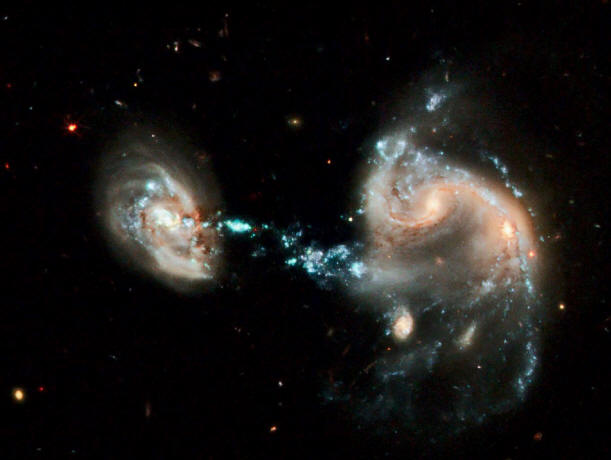The Shape of Things that Are
Jan 13, 2010
Galaxies are the luminous
children of electrical parentage,
not the darkling spawn of invisible
forces."Hear one side
and you will be in the dark. Hear
both and all will be clear."
--- Lord Chesterfield
A recent
press release opens with
these words: "Galaxies come in many
shapes and sizes, but until recently
astronomers have been at a loss to
explain why. Now scientists have
used dark matter theory to predict
the menagerie of galaxies found in
the Universe."
The standard model of galaxy
evolution relies on two principle
constituents, dark energy and cold
dark matter. The mathematical
description of dark matter is
plugged into computer programs that
create models of galaxy formation.
The quantities vary depending on
the source, but consensus astronomy
assumes that dark matter makes up
approximately 25% of the Universe.
So-called "dark energy" is said to
comprise more than 70%, with the
remaining 5% being the baryonic
matter that is visible to the
naked-eye and detectable with
instrumentation.
Astronomers use the term
"baryonic" in reference to all
celestial objects made of normal
atomic matter—that is, matter
composed of protons and neutrons.
Note that electrons are not
baryonic, they are "leptons", but
they are ignored on the astronomical
scale because protons are usually
accompanied by electrons.
Dark matter is described more by
what it is not than by what it is.
As stated above, it does not exist
as stars or planets that can be
seen. It is not dark clouds of
normal baryonic matter, because
baryonic clouds can be observed when
they absorb radiation. Dark matter
is not antimatter. Since gamma rays
are said to be created when matter
and antimatter annihilate each
other, dark matter would glow with
that high frequency light.
As the press release states,
researchers used the "Lambda Cold
Dark Matter" theory to write a new
supercomputer model that was able to
closely approximate the number of
spiral and elliptical galaxies that
can be observed.
Including dark matter in their
calculations was deemed "crucial"
because galaxies are thought to be
surrounded by "haloes" of dark
matter. Such large concentrations of
invisible material are essential for
galactic clusters to hold together,
as well as preventing individual
galaxies from "flying apart".
The confident assertions about
the model’s accurate predictions
must be balanced against the fact
that the equations have been created
to match observations. In order to
offer "predictions", many
assumptions must be considered
literal. However, as has been
pointed-out in previous Picture of
the Day articles, there are many
things the models cannot anticipate:
the large scale structure of the
Universe, for example.
Popular astronomy envisages dark
matter organizing galactic
structure. Another mathematical
genie, black holes, are also
important to the hypothesis, since
black holes are said to inhabit the
cores of almost every galaxy. Both
dark matter and black holes (as well
as dark energy) are necessary
mathematical constructs in the
astronomical community, because in
their minds gravity is the sine qua
non of all forces that govern
galactic motion in the cosmos.
A far different approach is taken
by those who consider the Electric
Universe theory.
Astrophysicist
Hannes Alfvén first
proposed his theory of “electric
galaxies” in 1981. Galaxies and
their motions resemble a
homopolar motor more than
they do anything else. A homopolar
motor operates because electric
current creates a magnetic field,
which causes a metal disc to spin at
a rate directly proportional to the
supplied current.
A galactic disc is like the metal
disc of a homopolar, or Faraday
motor, named for its inventor
Michael Faraday. Immense
Birkeland currents flow into
galactic axes and out along the
disc. Stars in the disc are powered
by those currents. Galaxies, in
turn, receive their power from
intergalactic Birkeland currents
that are visible in space as
filamentary structures traceable by
their magnetic fields.
Filaments of electricity can be
seen everywhere: static electricity
sparks, lightning flashes, “jets” of
x-rays that pour from galactic
poles, and the “strings” of
superclusters that make-up
large-scale structures in the
Universe. Birkeland currents are
drawn toward each other in a linear
relationship, with a long-range
attraction potential 39 orders of
magnitude greater than gravity, so
the need for dark matter influences
can be dismissed as completely
unnecessary.
Electric currents flowing through
dusty plasma energize and sustain
clusters, galaxies, and stars.
Stephen Smith
|







